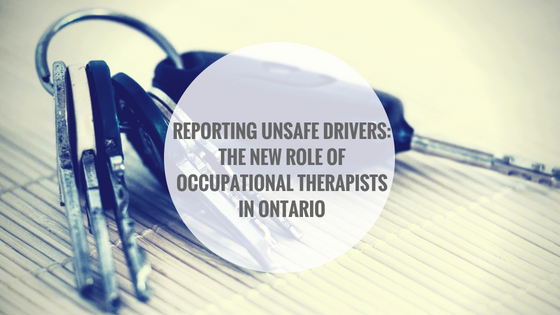Julie Entwistle, MBA, BHSc (OT), BSc (Health / Gerontology)
Co-written with Samantha Hunt, Student Occupational Therapist
My father-in-law was terminally ill and suffered from dementia. Eventually, his decline became significant and his doctor filed a mandatory report with the Ministry of Transportation (MTO) to suspend his license pending a driver’s exam. He refused to attend the exam yet continued to drive even without a valid license. He still paid for car insurance because he knew this was important but was not well enough to connect his own disabilities to his safety and the safety of others. The family planned to remove his vehicle from his possession but before we could he ventured out one night, got lost, and the police found him 8 hours later driving in a farmer’s field. The good news was that no one got hurt and his car was beyond repair. Now, he could no longer drive even if he wanted to.
Driving is an important daily activity for many and provides drivers with an independent means to get around and to manage our own needs outside of the home. It reduces our reliance on others and provides us with freedom and control. But it is a privilege, not a right, and sometimes people reach a point where driving is no longer safe, but yet they don’t voluntarily stop.
Up until recently, the ownness to report unsafe drivers has fallen to the legal responsibility of doctors, nurse practitioners and optometrists. However, on July 1, 2018 the legislation will change to add a new class of “discretionary” reporting, and occupational therapists will be included in the list of professionals that can submit these “discretionary” reports.
Considering this major change to the Highway Traffic Act (HTA), and the significance of this on OT practice in Ontario, we wanted to provide a brief overview of the key facts and guidelines for the OT’s that this may impact.
Background on Medical Reporting Legislation
Mandatory medical reporting for physicians and optometrists in Ontario has been in place since 1968 and was enacted to help protect the public from drivers diagnosed with certain medical conditions or impairments that made it dangerous for them to drive. Mandatory reporting is a legal requirement to report that pertains to physicians, nurse practitioners, and optometrists, outlined in the HTA. The legislation states that every prescribed person shall report to the MTO “any person who is at least 16 years old who, in the opinion of the prescribed person, has or appears to have a prescribed medical condition, functional impairment or visual impairment that may impair driving ability.”
What’s New
In 2015, amendments were passed that allowed for a new reporting model to be introduced in Ontario and were approved in February 2018. These include:
· A combination of mandatory and discretionary reporting
· Authority to add additional healthcare professionals
· Specific requirements regarding what must be reported
Resulting from these amendments, the MTO regulations state that as of July 1, 2018, occupational therapists are identified as discretionary reporters. Discretionary reporting is not a legal requirement but gives authority for reporting to occupational therapists, physicians, nurse practitioners and optometrists for: “any person who is at least 16 years old who, in the opinion of the prescribed person, has, or appears to have, a medical condition, functional impairment or visual impairment that may make it dangerous for the person to operate a motor vehicle”. Discretionary reporting therefore allows OTs to report concerns about a client’s fitness to drive if they choose.
With respect to consent and confidentiality, OTs are protected from legal action for breaking confidentiality when making a discretionary report; the HTA states that the authority of a prescribed medical professional making a report to the MTO overrides the duty of that professional to maintain a client’s confidentiality. Nevertheless, an OT making a report would be expected to advise the client of this decision.
Summary of Discretionary Reporting Rules for OTs
· OTs can report concerns about a client’s fitness to drive directly to the MTO. There will be a standard MTO form to be used for this purpose.
· OTS may report a driver but are not legally required to do so.
· OTs can make a report without client consent to prevent or reduce risk of harm.
· OTs can only make a report if they have met the client for assessment or service delivery.
· OTs can report on both prescribed conditions and any other medical conditions, functional impairments or visual impairment that may make it dangerous for a client to drive.
Prescribed medical conditions include the following:
1. Cognitive Impairment: a disorder resulting in cognitive impairment that,
i. Affects attention, judgment and problem solving, planning and sequencing, memory, insight, reaction time or visuospatial perception, and,
ii. Results in substantial limitation of the person’s ability to perform activities of daily living.
2. Sudden incapacitation: a disorder that has a moderate or high risk of sudden incapacitation, or that has resulted in sudden incapacitation and that has a moderate or high risk of recurrence.
3. Motor or sensory impairment: a condition or disorder resulting in severe motor impairment that affects co-ordination, muscle strength and control, flexibility, motor planning, touch or positional sense.
4. Visual impairment:
i. A best corrected visual acuity that is below 20/50 with both eyes open and examined together.
ii. A visual field that is less than 120 continuous degrees along the horizontal meridian, or less than 15 continuous degrees above and below fixation, or less than 60 degrees to either side of the vertical midline, including hemianopia.
iii. Diplopia that is within 40 degrees of fixation point (in all directions) of primary position, that cannot be corrected using prism lenses or patching.
5. Substance use disorder: a diagnosis of an uncontrolled substance use disorder, excluding caffeine and nicotine, and the person is non-compliant with treatment recommendations.
6. Psychiatric illness: a condition or disorder that currently involves acute psychosis or severe abnormalities of perception such as those present in schizophrenia or in other psychotic disorders, bipolar disorders, trauma or stressor-related disorders, dissociative disorders or neurocognitive disorders, or the person has a suicidal plan involving a vehicle or an intent to use a vehicle to harm others.
· OTs who make a report in good faith are protected from legal action but failing to report when they should have could be a breach of professional obligations.
OTs are NOT expected to report on conditions that, in their opinion, are of:
· A transient or non-recurrent nature
· Modest or incremental changes in ability
Lastly, although OTs are not legally required to make discretionary reports, a professional obligation to identify a potential safety issue with a client (such as a concern about fitness to drive) and, taking action to address this concern, is expected of the OT. Taking action may or may not include making a discretionary report to the MTO.
Next Steps
Reporting, Intake, and Review Process
The three types of approaches for assessing fitness to drive include a General Functional Assessment, Driving Specific Functional Assessment, and/or a Comprehensive Driving Evaluation (more information can be found in the resources below). Once an assessment has been completed or a concern has been identified, an OT may fill out a report. A new standardized form that OTs (along with physicians and nurse practitioners) must use when making a report has been approved and will be available online as of July 1, 2018. Once reports are received by the ministry, they will be reviewed and the MTO is to take appropriate action following within 30 business days. When an OT is reporting to the ministry, this does not mean the OT is taking the person’s license away. The licensing body has the responsibility to make this decision or to decide if more information is required.
For more information and resources, the College of Occupational Therapists of Ontario has created an Interim Guide to Discretionary Reporting of Fitness to Drive, which can be found at: https://www.coto.org/resources/interim-guide-to-discretionary-reporting-of-fitness-to-drive-2018
Resources
www.coto.org/news/changes-to-medical-reporting-of-drivers-gives-ots-new-reporting-authority
www.coto.org/resources/interim-guide-to-discretionary-reporting-of-fitness-to-drive-2018
www.mto.gov.on.ca/english/safety.medical-review.shtml
www.youtube.com/watch?v=dOIJ7CrDTT0


